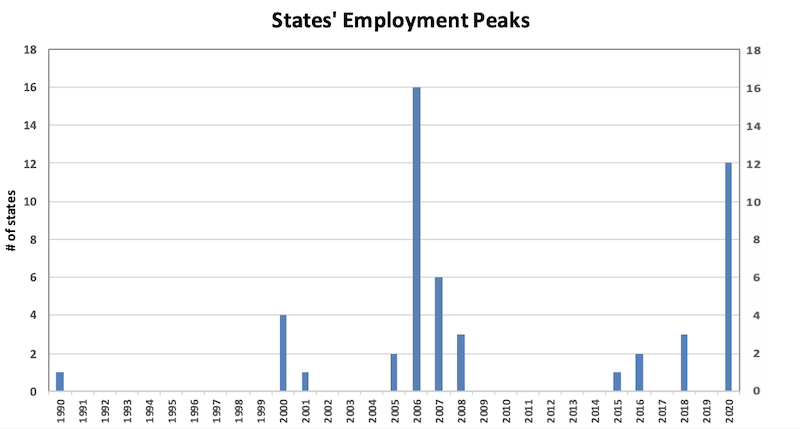Only eight states and the District of Columbia have recouped the severe pandemic-induced losses of construction jobs that occurred last spring, according to an analysis by the Associated General Contractors of America of government employment data released today. Association officials warned that job losses will become even more widespread unless lawmakers promptly renew and expand the loan program that enabled firms to temporarily retain and rehire many workers.
“New spikes in coronavirus cases, along with ongoing pandemic-related costs and revenue losses, are causing ever more private owners, developers, and public agencies to delay and cancel projects,” said Ken Simonson, the association’s chief economist. “Although single-family homebuilding is gathering steam, multifamily and nonresidential construction activity has stalled, leaving large numbers of workers at risk of losing their jobs as current projects finish up with nothing on the horizon.”
Seasonally adjusted construction employment in September was lower than in February—the last month before the pandemic forced many contractors to suspend work—in 42 states, Simonson added. California lost the most construction jobs over that span (-54,900 jobs, -6.1%), followed by Texas (51,800 jobs, -6.5%). Vermont had the largest percentage loss (-24.5%, -3,600 jobs), followed by Iowa (-14.6%, -11,400 jobs).
Of the eight states added construction jobs from February to September, Virginia added the most (4,300 jobs, 2.1%), followed by Utah (3,800 jobs, 3.3%). South Dakota posted the largest percentage gain (9.4%, 2,300 jobs), followed by Utah.
Construction employment decreased from August to September in 17 states, increased in 32 states, and was unchanged in Arkansas and D.C. Illinois shed the most construction jobs from August to September (-3,000 jobs or -1.4%), followed by Oregon (-2,600 jobs, -2.4%) and Iowa (-2,500 jobs, -3.6%). Iowa had the largest percentage decrease, followed by Oregon and New Mexico (-2.0%, -1,000 jobs).
New York added the most construction jobs over the month (5,300 jobs, 1.5%), followed by Louisiana (5,000 jobs, 4.1%) and Washington (4,200 jobs, 2.0%). Vermont had the largest percentage gain for the month (500 jobs, 4.7%), followed by Louisiana and New Hampshire (800 jobs, 3.0%).
Association officials warned that project cancellations are on the rise as new outbreaks of coronavirus across many states force many private owners and public officials to postpone or cancel planned starts. Association officials noted that the rapid adoption of Paycheck Protection Program loans last spring had enabled construction to bounce back quickly from the first round of project shutdowns and delays, and they urged lawmakers in Washington to act swiftly to extend and expand the program.
“The loans that were issued last spring saved tens of thousands of construction workers from unemployment but those funds are rapidly running out,” said Stephen E. Sandherr, the association’s chief executive officer. “Renewal of the loan program should be a top priority for any policy maker who cares about keeping the economy from backsliding.”
View state employment February-September data and rankings; August-September rankings; Highs and Lows.
Related Stories
K-12 Schools | Feb 29, 2024
Average age of U.S. school buildings is just under 50 years
The average age of a main instructional school building in the United States is 49 years, according to a survey by the National Center for Education Statistics (NCES). About 38% of schools were built before 1970. Roughly half of the schools surveyed have undergone a major building renovation or addition.
MFPRO+ Research | Feb 27, 2024
Most competitive rental markets of early 2024
The U.S. rental market in early 2024 is moderately competitive, with apartments taking an average of 41 days to find tenants, according to the latest RentCafe Market Competitivity Report.
Construction Costs | Feb 22, 2024
K-12 school construction costs for 2024
Data from Gordian breaks down the average cost per square foot for four different types of K-12 school buildings (elementary schools, junior high schools, high schools, and vocational schools) across 10 U.S. cities.
Student Housing | Feb 21, 2024
Student housing preleasing continues to grow at record pace
Student housing preleasing continues to be robust even as rent growth has decelerated, according to the latest Yardi Matrix National Student Housing Report.
Architects | Feb 21, 2024
Architecture Billings Index remains in 'declining billings' state in January 2024
Architecture firm billings remained soft entering into 2024, with an AIA/Deltek Architecture Billings Index (ABI) score of 46.2 in January. Any score below 50.0 indicates decreasing business conditions.
Multifamily Housing | Feb 14, 2024
Multifamily rent remains flat at $1,710 in January
The multifamily market was stable at the start of 2024, despite the pressure of a supply boom in some markets, according to the latest Yardi Matrix National Multifamily Report.
Student Housing | Feb 13, 2024
Student housing market expected to improve in 2024
The past year has brought tough times for student housing investment sales due to unfavorable debt markets. However, 2024 offers a brighter outlook if debt conditions improve as predicted.
Contractors | Feb 13, 2024
The average U.S. contractor has 8.4 months worth of construction work in the pipeline, as of January 2024
Associated Builders and Contractors reported today that its Construction Backlog Indicator declined to 8.4 months in January, according to an ABC member survey conducted from Jan. 22 to Feb. 4. The reading is down 0.6 months from January 2023.
Industry Research | Feb 8, 2024
New multifamily development in 2023 exceeded expectations
Despite a problematic financing environment, 2023 multifamily construction starts held up “remarkably well” according to the latest Yardi Matrix report.
Market Data | Feb 7, 2024
New download: BD+C's February 2024 Market Intelligence Report
Building Design+Construction's monthly Market Intelligence Report offers a snapshot of the health of the U.S. building construction industry, including the commercial, multifamily, institutional, and industrial building sectors. This report tracks the latest metrics related to construction spending, demand for design services, contractor backlogs, and material price trends.

















